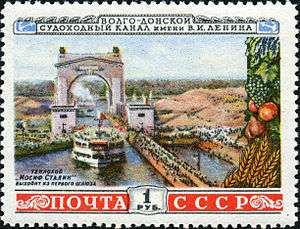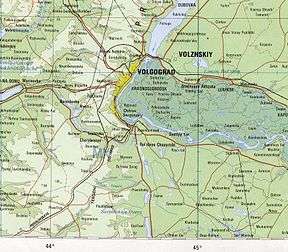Volga–Don Canal
Coordinates: 48°34′12″N 44°09′00″E / 48.57000°N 44.15000°E
| Volga–Don Canal | |
|---|---|
|
The Volga–Don Canal starts south of Volgograd, near the settlement of Krasnoarmeysk, and runs west and north-west, draining into the Tsimlyansk Reservoir near Volgodonskoy. The proposed Volga–Don II canal (not shown on map) would start north of Volgograd, near Yerzovka. | |
| Specifications | |
| Locks | 13[1] |
| Status | Open |
| History | |
| Date of first use | 1952 |
Lenin Volga–Don Shipping Canal (Russian: Волго-Донской судоходный канал имени В. И. Ленина, Volga-Donskoy soudokhodniy kanal imeni V. I. Lenina, abbreviated ВДСК, VDSK) is a canal which connects the Volga River and the Don River at their closest points. Opened in 1952, the length of the waterway is 101 km (63 mi), 45 km (28 mi) through rivers and reservoirs.
The canal forms a part of the Unified Deep Water System of European Russia. Together with the lower Volga and the lower Don, the Volga–Don Canal provides the most direct navigable connection between the Caspian Sea and the Sea of Azov, and thus the world's oceans.
History
As the lower course of the Don approaches the lower course of the Volga near today's Volgograd, the idea of connecting the two rivers by an artificial waterway has a long history. The first recorded canal work was done by the Ottoman Turks in 1569.
After capturing Azov in 1696, Peter the Great decided to build the canal, but, because of a lack of resources and other problems, this attempt was abandoned in 1701 without success. In 1701, he initiated a second attempt (the so-called Ivanovsky Canal at Yepifan) under the administration of Knyaz Matvey Gagarin. Instead of connecting the lower course of the Don with the lower course of the Volga near the present canal, the Ivanovsky Canal connected the upper course of the Don in what is now Tula Oblast. Between 1702 and 1707, twenty-four locks were constructed, and, in 1707, about 300 ships passed the canal under remarkably difficult navigation conditions. In 1709 due to financial difficulties caused by the Great Northern War, the project was halted. In 1711, under terms of the Treaty of the Pruth, Russia left Azov and Peter the Great lost all interest in the canal, which was abandoned and fell into ruin.[2][3] Over time, other projects for connecting the two rivers were proposed, but none was attempted.
The actual construction of today's Volga–Don Canal, designed by Sergey Zhuk's Hydroproject Institute, began prior to the Eastern Front campaign of 1941–1945, which would interrupt the process. From 1938 to 1952, construction was completed; navigation was opened 1 June 1952. The canal and its facilities were mostly built by gulag prisoners. In the 1930s the number of convicts employed in construction topped 200,000, with over 10,000 dying in the winter of 1931-32. A day spent at the construction yard was counted as three days in prison, which spurred prisoners to work. Several convicts were even awarded with the Order of the Red Banner of Labour upon their release.
Upon completion, the Volga–Don Canal became an important link of the Unified Deep Water Transportation System of the European part of the USSR.
Operation
The canal starts at the Sarepta backwater on the Volga River (south of Volgograd; Lock No. 1 and the gateway arch are at 48°31′10″N 44°33′10″E / 48.51944°N 44.55278°E) and ends in the Tsimlyansk Reservoir of the Don River at the town of Kalach-na-Donu. The canal has nine one-chamber canal locks on the Volga slope, which can raise ships 88 m (289 ft), and four canal locks of the same kind on the Don slope, which can lower ships 44 m (144 ft). The overall dimensions of the canal locks are smaller than those on the Volga River, however they can pass ships of up to 5,000 tonnes cargo capacity. The smallest locks are 145 m (476 ft) long, 17 m (56 ft) wide, and 3.6 m (12 ft) deep. Maximum allowed vessel size is 140 m (460 ft) long, 16.6 m (54 ft) wide and 3.5 m (11 ft) deep (the Volgo–Don Max Class).
The Volga–Don Canal is filled from the Don river; three powerful pumping stations maintain water levels. Water is also taken from the canal and used for irrigation.
Types of cargo transported from the Don region to the Volga region include coal from Donetsk, Ukraine, minerals, building materials, and grain. Cargoes from the Volga to the Don include lumber, pyrites, and petroleum products (carried mostly by Volgotanker boats). Tourist ships travel in both directions.
The Volga–Don Canal, together with the Tsimlyansky water-engineering system (chief architect Leonid Polyakov), form part of an architectural ensemble dedicated to the battles for Tsaritsyn during the Russian Civil War and for Stalingrad during the German-Soviet War. The Russian classical composer Sergei Prokofiev wrote the tone poem The Meeting of the Volga and the Don to celebrate its completion.
According to the Maritime Board (Morskaya Kollegiya) of the Russian Government, 10.9 million tonnes of cargo were carried over the Volga–Don Canal in 2004.[4]
An alternate (not necessarily comparable) source claims 8.05 million tonnes of cargo was transported through the canal in total in 2006. Most of the cargo was moved from the east to the west: namely, 7.20 million tonnes were transported through the canal from the Volga/Caspian basin to the Don/Sea of Azov/Black Sea basin, and only 0.85 million tonnes in the opposite direction. Just over half of all cargo was oil or oil products (4.14 million tonnes), predominantly shipped from the Caspian region.[5]
It was reported in 2007 that in the first 55 years of the canal's operations 450,000 vessels had passed through carrying 336 million tonnes of cargo. Recent cargo volume stood at 12 million tonnes a year.[6]

Future
In the 1980s, construction started on a second canal between the Volga and the Don. The new canal, dubbed Volga–Don 2 (Russian: Волго-Дон 2, Volgo–Don 2; 48°56′37″N 44°30′25″E / 48.94361°N 44.50694°E) would start from the township of Yerzovka on the Volgograd Reservoir, north (upstream) of the Volga Dam, as opposed to the existing Volga–Don Canal, which starts south (downstream) of the dam.[7] This canal would reduce the number of locks that ships coming from the Volgograd Reservoir – or from any other Volga or Kama port farther north – would have to traverse on their way to the Don. The project was abruptly canceled on 1 August 1990 due to financial considerations, although by that time more than 40 percent of allocated funds had already been spent.[7][8][9] Since then most of the stone and metal in the abandoned canal and its locks has been looted.[10]
As of 2007–2008, Russian authorities are considering two options for increasing the throughput of navigable waterways between the Caspian basin and the Black Sea. One option, for which the name "Volga–Don 2" has been reused, is to build a second parallel channel ("second thread") of the Volga–Don Canal, equipped with larger locks 300 metres (980 ft) long. This plan would allow for an increase in the canal's annual cargo throughput from 16.5 million tonnes to 30 million tonnes. The other option, which seems to have more support from Kazakhstan[11] (who would be either canal's major customer), is to build the so-called Eurasia Canal along a more southerly route in the Kuma–Manych Depression, some sections of which currently form part of the much shallower Manych Ship Canal. Although the second option would require digging a longer canal than Volga–Don, and would be of less use to vessels coming from the Volga, it would provide a more direct connection between the Caspian and the Sea of Azov. The Eurasia Canal would also require fewer locks than the Volga–Don, as elevations in the Kuma–Manych Depression are lower than the Volga–Don area.[12]
See also
References
- ↑ http://www.britannica.com/EBchecked/topic/632224/Volga-Don-Canal
- ↑ Plechko L.A. Old water routes, Moscow, 1985. (Russian)
- ↑ Ivanovsky Canal (Russian)
- ↑ Морская коллегия: Речной транспорт (Maritime Board: River Transport) (Russian)
- ↑ "Взвесить все" (Supplement to the Kommersant newspaper, No. 195/P(4012), 27.10.2008 (Russian)
- ↑ «Водный мир» для Евразии ("Eurasia's 'Water World'"), Transport Rossii, No. 28 (472) 12 July 2007. (Russian)
- 1 2 Петр ГОДЛЕВСКИЙ, «ВОЛГО-ДОН 2» — ШАГ В БУДУЩЕЕ. «Торговая газета», номер 4-5(434—435) от 23.01.2008
- ↑ D. J. Peterson, «Troubled Lands: The Legacy of Soviet Environmental Destruction»Chapter 3
- ↑ "ВОЛГО-ДОН-II: МЫ СТРОИЛИ, СТРОИЛИ И ЧТО?" (We have been building... So what?") Журнал «Власть» (Kommersant-Vlast Magazine), No. 30, 30.07.1990 (Russian)
- ↑ "Строительство второго Волго-Донского канала, на нужды которого в свое время было затрачено 750 миллионов рублей, было заморожено 10 лет назад. А приехавшие по призыву комсомола люди так и остались там жить." (14.11.2000)
- ↑ Nazarbayev insists on Eurasian canal construction Kazinform, 22 May 2008
- ↑ Analysis: Russia, Kazakhs eye rival canals

